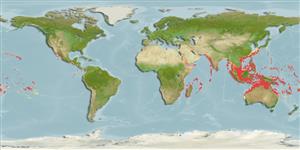Common names from other countries
Classification / Names / Names
Common names | Synonyms | Catalog of Fishes (gen., sp.) | ITIS | CoL | WoRMS
Environment: milieu / climate zone / depth range / distribution range
Ecology
Benthic. Tropical
Indo-West Pacific.
Length at first maturity / Size / Weight / Age
Maturity: Lm ? range ? - ? cm Max length : 12.0 cm CW male/unsexed; (Ref. 343)
Carapace subovate, swollen, surface smooth; setose area on pterygostomial and subbranchial regions small, not extending to branchiostegal region. Third maxilliped with well-developed flagellum on exopod, entirely covered by setae. Adult males with one chela greatly enlarged. Merus of legs not distinctly lined with stiff setae. Color: brown to brownish grey.
It has a low market value, caught by hand or with special traps, and is sold live (Ref. 106287). Semi-terrestrial (Ref. 97241). Inhabits back mangroves or similar brackish-water habitats. Larvae is released into the sea and return back to land upon completion of their development (Ref. 343).
Life cycle and mating behavior
Maturity | Reproduction | Spawning | Eggs | Fecundity | Larvae
Members of the order Decapoda are mostly gonochoric. Mating behavior: Precopulatory courtship ritual is common (through olfactory and tactile cues); usually indirect sperm transfer.
MarineSpecies.org. 2050. (Ref. 3477)
IUCN Red List Status (Ref. 130435)
CITES status (Ref. 108899)
Not Evaluated
Not Evaluated
Threat to humans
Harmless
Human uses
| FishSource |
Tools
More information
Age/SizeGrowthLength-weightLength-lengthMorphologyLarvaeAbundance
Internet sources
Estimates based on models
Preferred temperature
(Ref.
115969): 22.1 - 28.3, mean 26.8 (based on 726 cells).
Vulnerability
Low vulnerability (10 of 100).
Price category
Unknown.
